#rocky mountain construction
Text
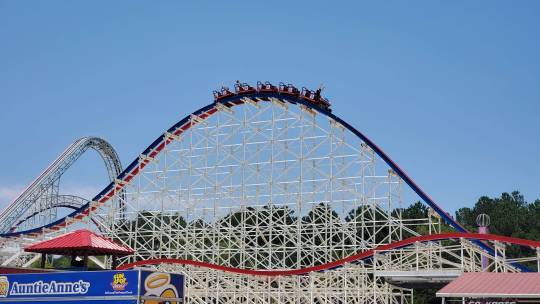






AerieForce One appreciation post, because I did 5 laps on it a few days ago and my thighs are still sore from the airtime. This thing's nut's. S-tier coaster!
#aerieforce one#fun spot#fun spot america atlanta#fun spot atlanta#roller coasters#amusement parks#rmc#rocky mountain construction#theme parks#atlanta#georgia
42 notes
·
View notes
Text




Also gonna post some of the photography I've done! As you can see, roller coasters are one of my favorite things to photograph, but I also like things like weather and abandoned industry as well. I'm a huge coaster fan tho, currently ridden 160 different coasters with no plans of slowing down!
#roller coasters#coaster#photography#my photos#coaster photography#cedar point#hersheypark#kings dominion#rocky mountain construction#bolliger and mabillard#Tac's Photos#coasterposting
28 notes
·
View notes
Photo

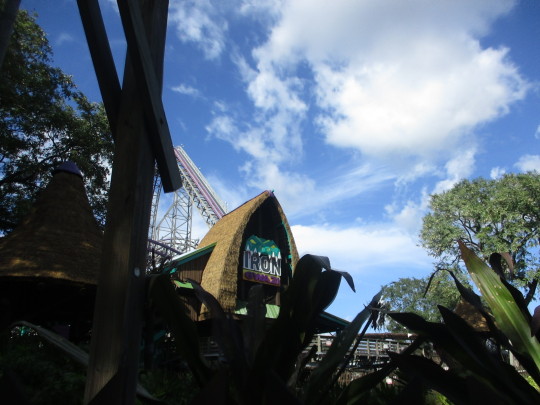
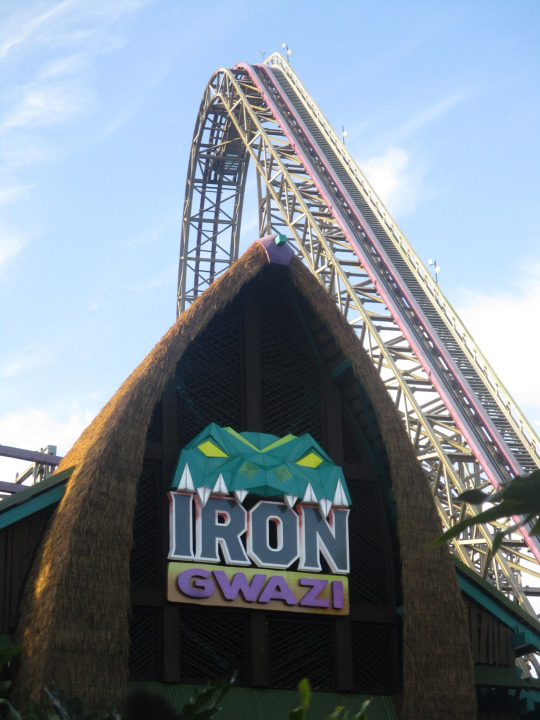
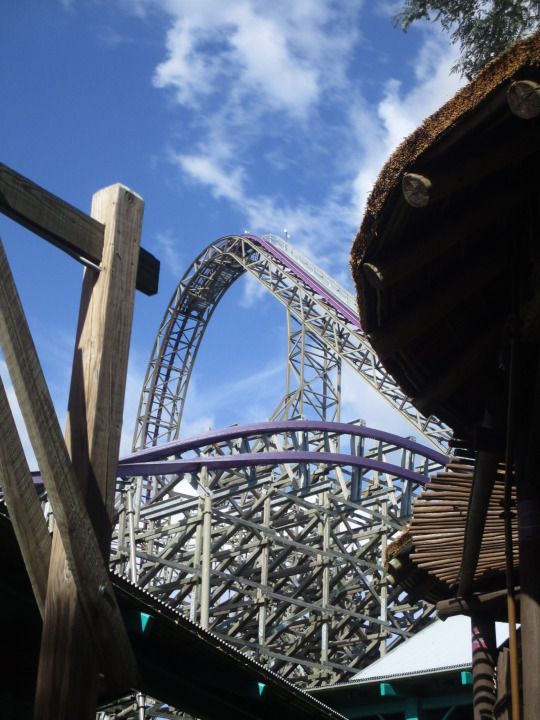
Iron Gwazi - Busch Gardens Tampa [November 7, 2022]
I can NEVER be consoled over the fact that I waited years to ride this thing, only to arrive on the day it was closed for maintenance
#busch gardens#busch gardens tampa#iron gwazi#gwazi#rmc#rocky mountain construction#amusement park#amusement parks#theme park#theme parks#roller coasters#roller coaster#rollercoasters#rollercoaster#coasters#tampa#tampa bay#florida#bgt#my photos#💜💚
11 notes
·
View notes
Text
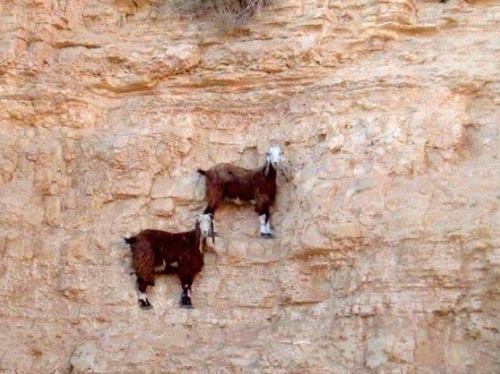
How on earth did these goats get there?
*****
In reality the goats are lying on their sides on rocky ground, looking up at a crane-mounted camera. The photograph was taken some years ago, part of a series reconstructing Central European folk customs and traditions which have fallen from favour or are now prohibited.
This old-fashioned rural blood-sport was originally practiced in parts of Anatolia, Turkey, where the game was called keçi fırlatmak, and also in the Carpathian Alps of Romania, possibly imported during the Ottoman conquest. The name there was aruncarea caprei.
*****
The goats would have been coated in a strong adhesive traditionally distilled from pine resin.(represented pictorially here by darker patches of dye on the flanks) and were then thrown upwards towards a cliff or rock-face with makeshift catapults, often a primitive form of counterweight trebuchet assembled from wooden beams and weighted with rocks.
The game ended when the glue dried and lost adhesion, and the goats fell to their deaths. They were then cooked and eaten, their meat being valued like that of Spanish fighting bulls.
The meat of the last goat to fall (başarılı keçi or cea mai durabilă capră) was prized as a special delicacy and selected cuts from the legs of this particular “winner” goat were often smoked and dried into a kind of jerky.
*****
In his “Grandes Histoires Vraies d'un Voyageur le 1er Avril” (pub. Mensonges & Faussetés, Paris, 1871) French folk-historian, anthropologist and retired cavalry general Gilles-Etienne Gérârd wrote about witnessing a festival near Sighișoara, Transylvania, in 1868.
There he claims to have seen catapults improvised from jeunes arbres, très élastiques et souples - “very springy and flexible young trees” - which were drawn back with ropes and then released.
Bets were placed before the throw, and marks given afterwards, according to what way up the goats adhered and for how long. The reconstruction, with both goats upright, facing outward and still in place, shows what would have been a potential high score.
The practice has been officially banned in both countries since the late 1940s, but supposedly still occurred in more isolated areas up to the end of the 20th century. Wooden beams from which the catapults were constructed could easily be disguised as barn-rafters etc., and of course flexible trees were, and are, just trees.
*****
Gérârd’s book incorrectly calls the goat jerky “pastrami”, to which he gives the meaning "meat of preservation".
While pastrami may be a printing error for the Turkish word bastırma or the Romanian pastramă, both meaning “preserved meat”, at least one reviewer claims that Gérârd misunderstood his guide-translator, who would have been working from rural dialect to formal Romanian to scholarly French.
Since this jerky was considered a good-luck food for shepherds, mountaineers, steeplejacks and others whose work involved a risk of falling, Gérârd's assumption seems a reasonable one.
However, several critical comments on that review have dismissed its conclusion, claiming "no translator could be so clumsy", but in its defence, other comments point out confusion between slang usage in the same language.
One cites American and British English, noting that even before differences in spelling (tire / tyre, kerb / curb etc.) "guns" can mean biceps or firearms, "flat" can mean a deflated wheel or a place to live, "ass" can mean buttocks or donkey and adds, with undisguised relish, some of the more embarrassing examples.
This comment concludes that since the errors "usually make sense in context", Gérârd's misapprehension is entitled to the same respect.
*****
The good-luck aspect of the meat apparently extended to work which involved "falling safely", since its last known use was believed to be in ration packs issued to the 1. Hava İndirme Tugayı (1st Airborne Brigade) of the Turkish Army, immediately before the invasion of Cyprus in July 1974.
Nothing more recent has been officially recorded, because the presence of cameras near military bases or possible - and of course illegal - contests is strongly (sometimes forcefully) discouraged, and the sport’s very existence is increasingly dismissed as an urban or more correctly rural legend.
The official line taken by both Anatolian and Carpathian authorities is that it was only ever a joke played on tourists, similar to the Australian “Drop-bear”, the Scottish “Wild Haggis” and the North American “Jackalope”.
They dismiss the evidence of Gérârd’s personal observation as “a wild fable to encourage sales of his book”, “a city-dweller’s misinterpretation of country practices”, or even “the deliberate deception of a gullible foreigner by humorous peasants”.
And as for those paratroop ration packs, Turkish involvement in Cyprus is still such a delicate subject that the standard response remains “no comment”.
84 notes
·
View notes
Text
Iwagakure Worldbuilding Headcanon
yes, it is time. i have been planning to do this ever since i wrote the suna ones. what inspired me to write these? my chem analytics lab practical

People and Culture
Iwagakure is a rather densely populated village, with its country having a rather large population. The citizens of Iwa are often times brutally honest with each other and often work as one big union. The language spoken in Iwagakure sounds similar to Konoha's language, but not quite (Almost like Dutch sounds compared to German). There are many different dialects across different valleys, every one sounding slightly different from the other. This sometimes leads to interesting dialoagues, but they manage. Many foreigners think Iwa citizens don't have a sense of humor, but they do. It's just that it's rather dry compared to what most foreigners are used to.
Infrastructure
A lot of the infrastructure in Iwagakure is made of stone and their architecture is very immaculate and they like using earth style to accentuate their homes. Despite their economy not being the strongest, Iwagakure has a homeless rate of 0% since housing is easy to construct there.
Education
In the Iwa academy, genin are not only taught ninja skills, but basic geology and chemistry as well. Despite Iwa nin being regarded as 'stupid' by outsiders due to their funny accents, they have an extensive education system.
Fireworks
Fireworks in Iwagakure are a special good, and they are very proud of the fact that they invented it. No one really knows how, but the story says that one shinobi of Iwagakure's explosion corps added copper sulphate, rubidium acetate, strontiom sulphate and lithium chloride into their explosive clay, creating a prototype of the fireworks they use nowadays. Using their knowledge of the different minerals and their flame test colors, the earth country's pyrotechnicians are able to create elaborate artworks out of thin scraps.
Clothes
Most clothes are dyed with either natural colorants or colorful chemicals. Most older people prefer the natural dyes from plants, such as ube, purple and orange carrots, etc. The youngsters are more adventurous.
Politics
Much like Suna shinobi, Iwa ninjas had more trust in their tsuchikage than in their own daimyo, however this recently changed due to Oonoki, the third tsuchi-kage hiring mercenaries like the Akatsuki to work behind the other big villages backs. Since the economy of Iwagakure was not the strongest, they often relied on imperialism as well as colonialism to build their economy. In the modern era, this has changed, however, since Iwa and the Earth country in general is the biggest exporter of rare minerals such as, diamonds, pottery, glassware and fireworks.

Flora
The Earth country is a cold and rocky place, with many gushes of wind carrying rock and debris throughout the country, even beyond its borders. The winters of Iwagakure are very cold and harsh and the summers are only mild compared to the fire country, where Konoha is located. There is little to no vegetation, and the vegetation that exists is used for agriculture which has led to many native animals being driven out of their natural habitat.
Fauna
The mountains of Iwagakure are populated by ewes, goats and sheep, which, much like in our world, could not care less about gravity. Another animal that can be found in such large heights is the snow leopard, a symbol of bravery and strength to Iwagakure shinobi. Wolves are also native to Iwagakure, however its citizens have an ambiguous relationship to the canines, as they frequently pillage livestock from the people. It would also be a crime to not mention yaks, the national animal of Iwagakure. Their meat, tar and fur are all highly prized and yak meat serves as a protein source to many Iwa shinobi. When looking up into the sky, eagles, kites, vultures and hawks are no rarity, feasting on any small mammal they might find. Fortunately for all arachno- and insectophobes, Iwagakure's insect and spider population is rather small, the only ones that survive living in such high altitudes either minding their own business or even being useful to its citizens, the iwagakure mountain bees, coming to mind.

Food
Tubers and Root vegetables
The main component of any Iwagakure dish are tubers and root vegetables. Iwa nin actually prefer them over grains as their main source of carbohydrates. The most popular ones are potatoes, purple carrots, parsnips and onions. Often times, ube and ube extract is used as a flavoring agent and colorant for food.
Legumes
Another important stable of Iwa cuisine are beans, which are imported from Sunagakure. The most popular variety are kidney beans, mainly due to their color matching the iwagakure shinobi uniform. In the past there used to be many lectin and cyanide poisonings, until the government stepped in and implemented 'how to properly cook beans' into the education system.
Meat
Most meat comes from either yaks, goats, dear or sheep. Unlike their close allies, Sunagakure, Iwa nin rarely dry their meat and prefer it marinated or jarred.
Sweets
Similarly to Kirigakure, not many manufactured sweets can be found here, however, crispy rice cakes (Iwagakure rock mochi) are a specialty. The most popular filling for these rice cakes is, of course, red bean paste.
#naruto#naruto shippuden#naruto headcanons#naruto imagines#naruto scenarios#naruto fanfiction#akatsuki#headcanons#fanfiction#deidara headcanons#deidara#iwagakure#iwa#naruto worldbuilding#worldbuilding
82 notes
·
View notes
Note
Cybertronian Liminal spaces ideas: TFP
Tunnels (thru Mts, under cities, etc.)
Red Sand Deserts (Rust Sea Similarities)
Large Scale Industrial Sectors (Think big, automated assembly lines; Similar to their factories)
I also feel like truly gigantic cities (Lots of skyscrapers; similar to their cityscapes) would be similar enough to evoke a sense of nostalgia.
Cybertronian Specific Places:
OP - Libraries (the bigger the more nostalgic he gets) and Rome, b/c of the Collusium (I imagine it reminds him of Kaons Arena)
Megs - Rome (Same as OP), Empty Mines, and ruined Forts (even tho their forts 100% looked different, our ruins still give the same effect)
Ratch - Colleges (Academy Days, specifically the long, winding trails from one building to another), Hospital Corridors (If he has a holoform) and Oddly enough, Victorian Houses. Old and creaky, reminiscent of an old era.
Star - The Buj Kalifa (Vosian Remenicent). Sometimes Specific weather patterns, like Hailstorms or Freezing Rain, remind him of the stinging Acid rain of Cybertron. He hates Blizzards too.
Bulk - Construction sites get him. Rome as well (architecture in general, really).
Sounders - Rome, Government Buildings (specifically, the twisting hallways some important buildings have) and castles/forts.
Arcee - Tunnels, Ravines (I imagine she hid a lot on cybertron, cracks in cybs exoplates would be similar to ravines), and old houses (dilapidated buildings, slowly rotting away; similar to one specific spider incident.
KO - Raceways (obv), but also airports (hanger bays specifically) and large scale paint factories. Also, Buj Kalifa (HC that KO is a Grounded Seeker, explaining SS comment in TFP). Maybe medical tents as well? He was a front line medic after all.
Bee - Rocky mountain roads (scouting), ruins like Stonehenge, and ghost towns. Places where life has been destroyed. Also, war ravaged cities and mysterious old paths through the trees.
BD - Similar to Bulk, but add Mines and industrial buildings too.
Smokey - Libraries (not to the same extent as OP tho), old ruins, and abandoned junkyards (similar effect to the transport ship) I also HC that the escape pod made him pretty Claustrophobic. So small spaces are a no go.
Shockers - Labs, research buildings, but also government buildings (Senator days) and hospitals (too pristine/white a room; he slightly panics) HC that Shockers hates the color white with a dying passion.
Jackie - Labs as well, but also hanger bays and random bars get him too. (HC that he basically found Seaspray in a galactic bar.)
Dread/Quake - Old English/French architecture and Rome
Mags - Government buildings, Libraries (somewhat), but mainly offices and conference rooms get this guy.
Arachnid - Dug out Tunnels (insecticon hives), fancy buildings (Senete esch enough; similar to all her targets homes), and out-of-the-way villages (similar to other organic planets easiest targets)
I think that basically everyone (everyone important I think? Cliffs dead so I didn't include him lol).
HOOOOLY FUCK man you put a LOT of thought into this, this is so cool. The bit about lifeless or decayed places igniting that kinda nostalgia in Bee is actually really sad if you think about it.
Man now I wanna see an episode where a relic is found near the remains of the colosseum, and it has a lot of bots on edge.
I feel like the cities with big reflective or iridescent skyscrapers are spot on, especially in the flashbacks. To add to city scenes, in the flashbacks they had huge streets and ramps and freeways that looked a lot like ours too! (Unless I’m remembering wrong and I’m just nuts)
#tfp#transformers#transformers prime#optimus prime#megatron#starscream#bulkhead#tfp arcee#ultra magnus#tfp breakdown#tfp knockout#tfp airachnid#tfp shockwave#tfp soundwave#tfp bumblebee#tfp smokescreen#wheeljack#tfp ratchet#dreadwing#skyquake#liminal spaces#liminal nostalgia
55 notes
·
View notes
Text

I must say that animals are quite the architects sometimes. I feel like it doesn't get acknowledged enough. Us sapient species like to pretend that we are the only ones who do it, that no simple creature could ever achieve such a thing. But look at the intricate nests of birds, the incredible spires of the Mountain Makers and the gorgeous weaving of spiders! How can we pretend these are inferior? Each are so beautiful in their own right, and impressive in their design and complexities! I would say that there are many animals out there that earn the title of "builder" and "architect." In the case of the Mason Maw Carcolh, it is right in the name!
Mason Maw Carcolhs are certainly a member of the Carcolh family, being large shelled mollusks who are known for their impressive size, appetite and adaptations. The Mason Maw is one that shares a similar range with the regular Lou Carcolh, though they tend for rockier areas, but there is no way you would ever get the two confused! First off is that blazing orange color they have! Quite gorgeous and eye catching! Then comes their shell, or what stands in place of their shell. Mason Maws do have shells like the majority of their family, but you rarely ever see them because they are always buried beneath these odd stone constructions. In fact, a whole lot of the Mason Maw is covered in these rocky plates and growths! What's the deal? Do they carve stone and wear it like armor? Not really! The secret behind these structures can be found with the Mason Maws.....well....maw.
These carcolhs have a noticeable pouch formed around their radula, and here the snail produces copious amounts of a gray sticky substance. This paste-like gunk is referred to as "mortar," and the carcolh fills this pouch with as much as it can carry! Maybe that should tell you about the origins of their name, eh? Obviously, though, mortar in the mouth doesn't explain how they have all this stuff on their shell and back. To figure out how that happens, just look to their oral tendrils. Unlike the Lou Carcolh, these aren't nearly as hairy or sticky, and they have special structures on their ends. Any builder or mason would recognize these shapes in an instant! They are the tools the carcolh uses to scoop mortar out of its mouth and spread it onto whatever surface it wants, be it the earth or its own body! Once the mortar is removed from its moist radula pouch, it will begin to dry and harden at a rapid rate. It can turn rock-like in only a few minutes, which means the Mason Maw must work fast! But once it does finish drying out, it can be just as tough as stone! Quite useful, and for a variety of reasons!
Just like its other brethren, the Mason Maw likes to take its prey by surprise. At the speed these snails move, you can certainly rule out the tactic of pursuit. These ones use their stony exterior to blend in with surrounding rocks and landscape, remaining perfectly still as it waits for food. How it catches prey can vary depending on the situation. In most cases, the Mason Maw vomits out a whole bunch of mortar onto its victim when they get close, and the paste sticks fast to fur and hide. The weight and stickiness alone can slow food down enough for the tendrils to grab hold and reel them in. Even if they run, it won't take long for the stuck on mortar to harden. Victims will find themselves slowly petrifying, as their limbs get locked up from the hardening mortar and the weight becomes too much to carry. In minutes, they will be rendered a partial statue, trapped in this stony cocoon as the Mason Maw slowly follows their trail. I can't imagine how terrifying it would be, being stuck in these stone shoes as you watch your painful demise creep towards you inch by inch.
In other cases, the Mason Maw may set a trap. They can either find a shallow hole in the environment or dig one out with their tendrils. Whichever is the case, they then fill the hole with mortar til it is almost level with the rest of the earth. They will then apply a special mucus coating to this pit of gunk, which forms a layer that prevents it from hardening too fast. This mucus is used on their body in places they don't want the mortar to form, that way they don't get bogged down or trap their own movements. The Mason Maw may cover this layered puddle with loose vegetation or dirt, or they may leave it as is. With the mucus layer on top, it gives the reflective look of a pool of water. They then wait, and hope that prey trundles by and steps on this spot. When they do, their limbs will punch right through the disguise and moistening mucus, and straight into the sticky mortar. They will suddenly find themselves in a makeshift tar pit, struggling to get free. This is usually enough for the carcolh to slink out of its hiding place and take them down. No matter how you are caught, death by shredding against their razor toothed radula is certain.
This mortar sure is handy for making traps and catching prey, but what else can it do? Just look to its shell and see the answer! It is great for defense, creating stone hard plates and rocky armor. The Mason Maw layers its back with mortar to create this intricate armor, which protects it from predators. This prevents the Mason Maw from retracting into its shell, but it seems to work just as good! And speaking of shell, that impressive mass of sculpted mortar is their masterpiece! All Mason Maws use their mortar and tendrils to build upon their shells and create unique pieces of art! While it certainly works great for defense, it is also believed to show off strength, health and win over mates! I have to imagine there is a bit of pride in it too! While they certainly use mortar for the majority of their construction, they also like to add extra bits to it. Shiny rocks, leftovers from prey, random pieces of pretty junk, and even old armor and weapons! Infamous Mason Maws tend to have the armor and blades of knights and slayers built into their shell spires, carried like trophies of previous battles.
Some stories claim that the Mason Maw may trap live prey within these constructs as well! It seems improbable, but they do have paralytic venom and the mortar cures pretty quick. It is probably a rare scenario, but certainly a horrifying one! Imagine being carried around like a piece of jewelry, waiting to be freed by either heroes or death! Pretty freaky! Mason Maws work on these shell sculptures their entire lives, always adding to it or repairing it when needed. In some cases, the carcolh may be so old and intent on making its sculpture bigger that it can trap itself under its own weight! Making a shell too heavy to even carry! If this happens, the carcolh is kind of doomed unless something breaks enough chunks off to lighten the load, or if enough prey is dumb enough to walk right in front of the trapped snail.
Now you may be wondering what society thinks of these strange snails and their intricate sculptures. They are still flesh eating mollusks who won't hesitate to go after any meat in front of them, but do these ones differ in any way? Why yes they do! In fact, humans worship these incredible snails! Take another look at that shell and the mortar creations. Look familiar? Why, it looks like a castle! And humans build castles too! You seeing the link here? Indeed, humanity learned all they know about masonry and rock stacking from these incredible snails, whose unique adaptations ignited a whole new era for humanity. They saw the wondrous mortar and witnessed its use in building great spires and binding one rock to another. From there they were inspired, and they wound up creating the very castles and walls you see to this very day! Why, it is hard to imagine what would have happened to man if they never met a Mason Maw! Would they have ever stumbled upon the secret technique of sticking two bricks together? Well, I think....that I am totally messing with you.
No, humans did not learn how to build stone structures from Mason Maws, I was just being a goof. It is mainly because I keep reading about stuff where some people love to attribute great creations to anyone and anything save for the people who actually made them. They love their fantastical ideas of knowledge from the gods or secret magics lost to time, all while the folk that put in the time and effort to actually construct these things get ignored. Kind of awful, if you ask me. So that is why I did the whole "humans couldn't have possibly built castles on their own thing." Wait, should I be explaining the joke? Probably not, but it wasn't the greatest one to begin with...
So what do people actually think of Mason Maws? They think they are impressive and intriguing when they are a good distance away and not ambushing travelers or livestock. Their shells are admired for their incredible structure and arrangement of random pieces, to the point where empty ones are displayed like art. Some folk even hunt Mason Maws to get the goods that are buried inside all that hardened mortar. I recall a tale where a jewel thief was escaping the law with a whole sack full of goodies when they fell into a Mason Maw trap and were devoured. The stolen stash was then added to the snail's personal artwork, suddenly making it priceless! A whole number of slayers, knights and folk eager for lots of money went running after that unwary snail! The poor thing! It was probably so confused why it was suddenly the most "popular" carcolh around! Sadly, I don't think these people came to admire its craftsmanship!
Chlora Myron
Dryad Natural Historian
---------------------------------------------------
Hey, since its August, that means its Smaugust! So that means I am going to aim to be posting dragons! So here's one! Another snail dragon! Though it isn't exactly called that. And yes carcolhs aren't dragons. Certainly not True Dragons! Look do you want the snail or not?!
92 notes
·
View notes
Text
.
Both Sides Now by Joni Mitchell
.
@anjo-by-the-sea
People have been making flutes for over 35,000 years now. How difficult can it be?
Before COVID, I used to attend "Flute Circles" in the area west of the Rocky Mountains in North America. Mostly, it is or was people who play Native American flute sitting around playing for and with each other. I was playing a transverse flute made from bamboo by fellow in Portland Or. I have a pinched nerve in my neck, and playing transverse flute was causing me to grind on it badly. Lots of pain and numbness in my right hand.
One of the flute players who came to circle one day was plaing Xiao (Pronounced more like Sow) and had imported a few to sell. In an attempt to escape the pain but continue to play I made the switch.
Over time the flutes cracked and broke. My sweetie decided I was spending too much money on flutes and needed to start making my own. This is now the 3rd flute, maybe my 4th that I've made for myself. It is also my cane, when I walk outside my home it goes with me. The last one broke because of water problems. I was using it to help as I was wading in the local river looking for agates and petrified wood.
It is a learning curve. You have to construct or improvise your own tools as you learn. The rest of the question is I'm a life long learner. I built a simple flat file driven object oriented database at work when I did work back in the day. There is a reason I place such value on questions. I can ask assorted public databases and learn an assortment of things that I find Interesting.
30 notes
·
View notes
Photo
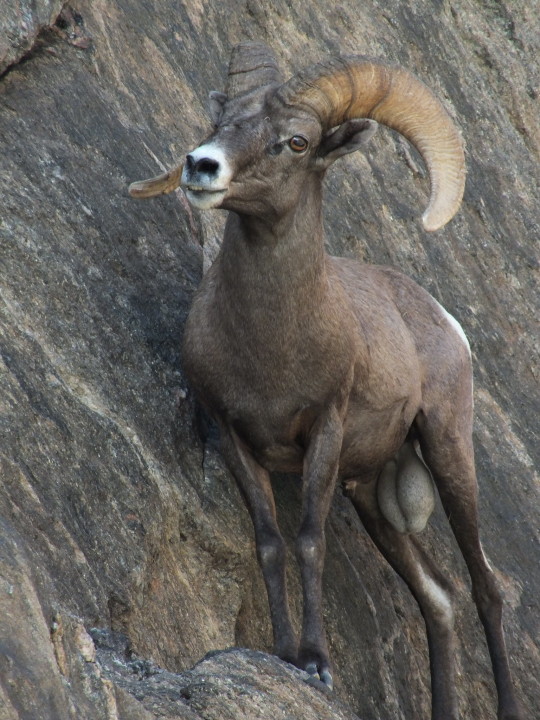

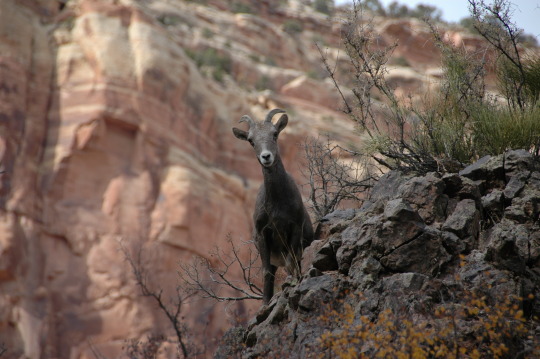
Big-Time Bighorn Sheep
Found throughout the Rocky mountains of western North America, the bighorn sheep (Ovis canadensis) is one of only two sheep native to the continent. They mainly inhabit rocky alpine meadows, at elevations of 800-2500 m (5,000-8,500 ft). The subspecies Ovis canadensis nelsoni occupies lower elevations, and lives in the deserts of the southwestern United States and northern Mexico.
Bighorn sheep are named for the large, curling horns-- known as curls-- carried by the males, or rams. These horns weigh as much as all the rest of the ram’s bones put together, up to 14 kg (30.8 lbs). Males themselves weigh up to 127 kg (279.8 lbs) and stand 105 cm (41 in) tall at the shoulder. Females, or ewes, are much smaller, at 91 kg (200 lbs) and 90 cm (35 in), and their horns are shorter. Both sexes sport short, grey-brown coats with white underbellies and behinds. Their hooves are split, and well adapted to cling to rocks and steep cliffs as they forage.
O. canadensis is herbivorous, and spends most of the day searching for grasses and brush to graze on. In addition, many bighorn sheep can be found at naturally-occurring salt licks where they can acquire minerals not available in their primary diet. Despite their large size and hazardous home environment, bighorn sheep can be hunted by wolves, bears, lynx, and mountain lions. Lambs are particularly targeted, and can even become food for golden eagles which are large enough to carry them away.
Outside the mating season, males and females live in separate groups. Often times, the males will form homosexual societies, in which members of a group court and mount each other in the same way they do females. Some rams, however, chose to live with the ewes and their young, and adopt a number of female mannerisms- though they refuse to be mounted by males.
Rutting season begins in September or October, and lasts through early December. During this period, rams engage in the head-to-head combat for which they are famous in order to construct a social hierarchy. Once this structure is established, males begin courting the females; ewes will accept multiple partners while in oestrus, which lasts for about three days. They then carry their young for 150-180 days before giving birth to one or two lambs. These young are extremely precocial, and after a few weeks will form groups of their own and seldom return to their mothers. Individuals reach sexual maturity at one or two years old, and can live anywhere from 7 to 19 years in the wild.
Conservation status: The bighorn sheep’s population has been severely reduced due to overhunting, introduced diseases, and competition from livestock. Several of O. canadensis’s subspecies are endangered. However, the species as a whole is considered Least Concern by the IUCN.
If you like what I do, consider leaving a tip or buying me a ko-fi!
Photos
Tyler Creech
Sally Bellacqua
Diane Renkin
#bighorn sheep#Artiodactyla#Bovidae#sheep#goat-antelope#bovids#even-toed ungulates#ungulates#mammals#mountains#mountain mammals#grasslands#grassland mammals#deserts#desert mammals#north america#western north america#central america#queer animals#queer fauna#biology#zoology#animal facts
120 notes
·
View notes
Photo
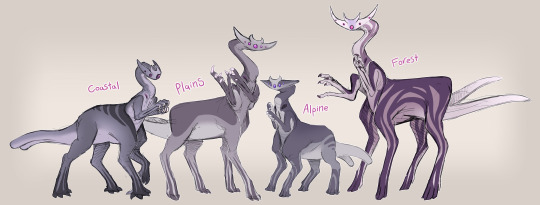
Got my comp set up at my inlaws so I am back on the net! Time to get into chimera variants! Buckle up this is an info dump below.
Chimera actually get their common name because they come in a LOT of different shapes once their society advances enough to discover magical body modification. Something that I’m going to have to make a few posts about but these are the ‘starting styles’ so to say. They are based off of different populations in Mirum who occupied different areas of the continent prior to chimera becoming one unified culture.
Coastal- These chimera are living the closest to the ancestral chimeric niche. They live in the island chains and Western/Southern coasts of Mirum, live in very small nomadic family groups. Most distinguishing features of them is the fact that their faceplate does not fully flatten out upon maturity, leaving them with a much wider field of view and a more streamlined body. They also have partially fused trunks, much wider splayed toes, and long thin teeth. These are the fellas built for a much more aquatic life, fast swimmers but a little clonky on land.
Plains- The stock standard. These are the most common ethnicity of chimera by a mile, populating the vast floodplains of the continents interior. They are lean and quick on their feet, with endurance equal to their speed. The majority of their diet still relies on the waterways around their settlements, but they don’t turn their nose up at fruit and veggies. Think of them as the transitional form, venturing into spending most of their time on land, but still very tied to the water. They live in large towns with many different families coming and going, sometimes far enough to run into the others!
Alpine- Short and stout, these fellas are pretty much the only variety of chimera able to inhabit Mirum’s Southern mountain chain. They are built for the cold, with much more bristled nostrils and bellows to keep out the chill and padded toes to help them climb their rocky home. These guys aren’t particularly fast but they really have no need to be for these are the only chimera that don’t regularly worry about predation, the largest carnivores in the mountains are terrestrial birds which very rarely target larger prey. Their main worry is food, they have moved off of fish to meat, leading to them going from actively hunting to more trapping and farming. They live in small towns with very few ever leaving aside from trading, but that’s not infallible.
Forest- From the forest/jungle covering the Eastern side of the continent come the largest of the chimera, these guys are tall and lean. By far the fastest yet quickest to tire, they’re the most magic reliant of the bunch. The classic squishy caster. They live a calm life and worry far more about Antlerworms than Histin, so they are able to be a bit more lax on their building construction. Their towns are small but known for large sprawling buildings, often built around and through some of the larger trees in their range. Again they have weaned off of fish somewhat, but still actively chase down their meat. For their greens they have taken to orchards within felled portions of forest.
That’s the basic ideas, but all of them have far more in common with each other than not. They all ‘speak’ the same ‘language’, recognize the same creator, and generally no issue with accepting others into their communities. As time goes on the boarders between them begin to blur until most chimera have a little of every background within them.
#chimera#fantasy#spec bio#speculative biology#art#mirum#worldbuilding#they end up looking a lot different than this so it gets crazy#no true north
267 notes
·
View notes
Note
https://exploringgreece.tv/destinations/eyvoia-to-mystiriodes-drakospito-sta-1-300-metra-ypsometro/28433/
Came across this article and i am surprised i didn't know about these "dragon houses" ( δρακοσπιτα) and not only that they are high in the mountains but also they date really old , we are talking 5.000 B.C 😳
Yep that... phenomenon is very interesting and pretty unknown to many Greeks and tourists alike. But it's not that old, it's from around 500 BC according to most estimations, with a broad 1200 BC - 100 BC range of possibility.
The Dragon Houses are more than 20 ancient megalithic constructions that can be found in various peaks in the south of Euboea island. The buildings have a mild pyramid like shape on their roofs and they are built with giant slabs from the region that were somehow processed first, in a way that provided a lot of stability. Some interiors have details like shelves. They have neither foundations nor windows. Some of the stone slabs weigh almost 10 tons and they were processed to fit perfectly with each other so that no extra binder was used at all. Most of the dragon houses are built in significant altitudes given how ancient they are and especially the ones in the peaks of Mount Ohi (Όχη with an η) are remote enough that it is hard to imagine how they were built. Ohi is not huge (~1400m - 4600 ft) but it is a very rocky mountain with dangerous flimsy terrain and narrow trails between cliffs. The difficulty to explain the houses' creation led to folk lore, according to which dragons lived there and terrorized the populations of the mountains.
In 1959, archaeologist professor Moutsopoulos discovered pieces of ancient pottery up there as well as undeciphered scripts.
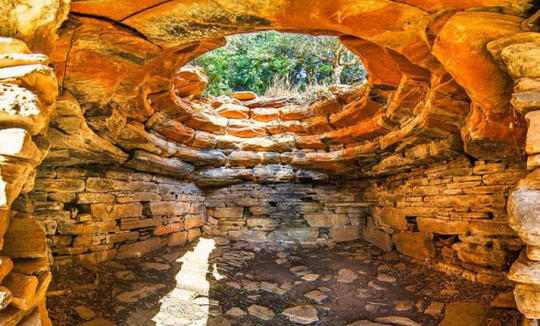
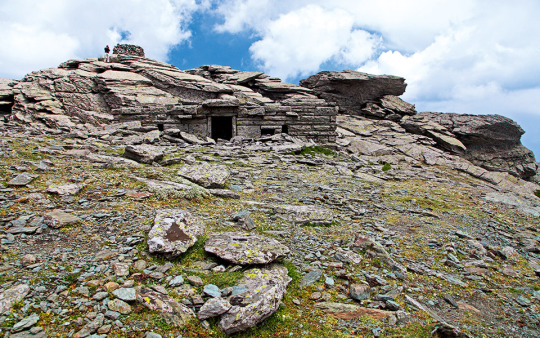


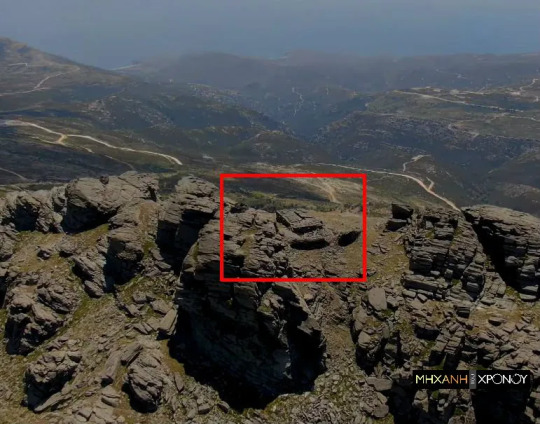
Also important picture:

#greece#europe#travel#greek islands#ancient culture#megalithic#greek facts#dragon houses#euboea#evia#sterea hellas#central greece#anon#mail#link
44 notes
·
View notes
Text
Ishgard & The Coerthas Highlands (1/3)

The Nail, Coerthas Central Highlands
As is described in the Enchiridion, to ensure the realm of man did not drift apart from the firmament, Halone struck the Nail through both, ever binding the two. And though assailed on all sides by great metal shards fallen from the lesser moon Dalamud's crust, the ancient peak remained standing, a testament to the land's life force.

The Observatorium, Coerthas Central Highlands
Three hundred years ago, Ishgardian astrologian Adaunel the Younger convinced the Holy See that he could predict the comings and goings of the Dravanian Horde by studying the movements of the heavens, and thus secured funding for the construction of the First Dicasterial Observatorium of Aetherial and Astrological Phenomena and its grand astroscope.
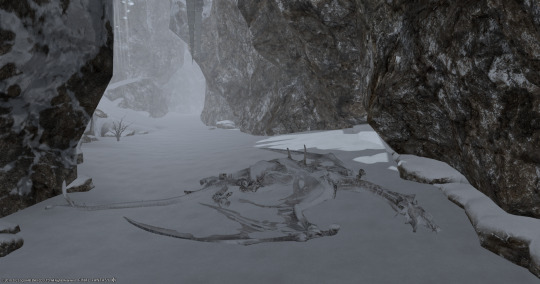
The Frozen Fang, Coerthas Central Highlands
In years past, the hot alpine summers would have seen this fallen Dravanian outflyer blown with maggots and reduced to bones in a matter of days. Now, in the endless winter wrought by the Calamity, the carcass rests in the permafrost under a thin blanket of snow, perfectly preserved since the day he was pierced through the heart by a ballista.

The Holy See of Ishgard, View from Coerthas Central Highlands
For the past thousand years, Ishgard has waged a bloody war with the dragons of Dravania. To fend off the enemy horde, a complex web of defenses, magical and corporeal, have been added piecemeal to the city proper's outer walls, transforming her into an impenetrable bastion, while at the same time, isolating her and her people from the outside world.
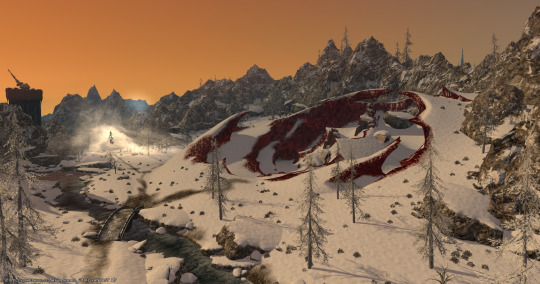
Boulder Downs, Coerthas Central Highlands
Before the Calamity, Boulder Downs was a vast sloped lea littered with moraine deposited by realm-swallowing glaciers long receded. The rain of debris that accompanied the fall of Dalamud, however, transformed the landscape into a frozen wasteland pocked with gaping impact craters and peculiar dark matter formations.

The Fury's Gaze, Coerthas Central Highlands
A place holy to all Ishgardians, it is believed that when a man stands within this hidden grotto, the Fury Herself will reach deep into the darkest recesses of his soul and lay out his sins before him, allowing the man to repent those failings. The Monument Tower nearby was built to protect this hallowed ground from the taint of dragons and heretics.

Snowcloak, Coerthas Central Highlands
The bitter cold which swept over the Coerthas highlands following the Calamity did not only blanket the region in snow and ice, but transformed the water of Twinpools and the Swiftrun into a mountainous flow of ice—a flow which has slowly crept through western Coerthas highlands and now has completely engulfed Gargoyle Crossing, preventing passage.

Camp Dragonhead, Coerthas Central Highlands
Its name taken from a rocky outcropping said to be the head of a Dravanian king turned to stone by the almighty hand of Halone, this outpost acts as the Coerthas central highlands' southernmost line of defense for the Holy See, tasked with fending off Ixali raids from Natalan, incursions by heretic factions, and the occasional yeti scare.

The Steel Vigil, Coerthas Central Highlands
One of four citadel watchtowers built along the Sea of Clouds, the Steel Vigil warned the Holy See of aerial attacks for centuries before being razed and gutted by the Dravanian Horde and their vile commander, Svara. Now, only the outer walls remain, leaving a bitter reminder of the dragons' destructive power.
Indie's Sightseeing Log
Limsa Lominsa & La Noscea (1/3)
Limsa Lominsa & La Noscea (2/3)
Limsa Lominsa & La Noscea (3/3)
Gridania & The Black Shroud (1/3)
Gridania & The Black Shroud (2/3)
Gridania & The Black Shroud (3/3)
Ul'dah & Thanalan (1/3)
Ul'dah & Thanalan (2/3)
Ul'dah & Thanalan (3/3)
Mor Dhona (1/1)
Ishgard & The Coerthas Highlands (1/3)
Ishgard & The Coerthas Highlands (2/3)
Ishgard & The Coerthas Highlands (3/3)
Dravania (1/4)
Dravania (2/4)
Dravania (3/4)
Dravania (4/4)
Abalathia's Spine (1/3)
Abalathia's Spine (2/3)
Abalathia's Spine (3/3)
#ishgard#coerthas central highlands#ffxiv landscape#ffxiv sightseeing log#text from in-game sightseeing log descriptions#time of day and weather conditions accurate for the log#vista positions are not#ISHGARD IS SO PRETTY!#indie's adventures#ffxiv
23 notes
·
View notes
Note
Hey!!! Since you said you have a lot figured out for your WIPs I'm interested in your answers!!
what natural resources does each nation have that the others don't? do they export/trade it at all? (For any WIP you wanna answer for!)
@bloodlessheirbyjacques 👀❤️🔥
JACQUES, I LOVE YOU!!!!!! I'll try to keep this at least somewhat brief, but be warned, you have NO idea what floodgates you have just opened.
(I actually intended to make a post like this literally over a year ago, so thank you for helping me make it!!)
Get ready for:
Econ 101 - A Crash-Course in Continental Trade Policy
Before we get started, here's some things you might find helpful:
a map of the continent (see below)
an explanation of why Anvia and Oryn don't get along
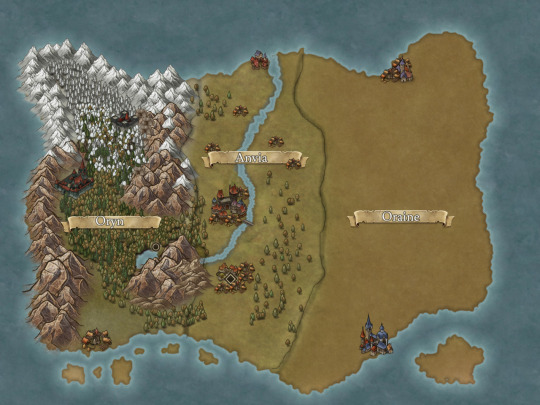
under the cut because hoo boy, this is a LOT.
Anvia, the kingdom where ATQH takes place (and which Fallon rules) is primarily an agricultural society. The country's position in the middle of the continent, plus the river running through the kingdom providing fertile land, gives makes it the best-suited area for agriculture on the continent.
(Side Note: It gets colder as you got west-northwest on this continent. Oryn is cold, with long winters and short summers, while Oraine is extremely hot and the land dries up quickly.)
They grow crops and raise animals not only for their own survival, but for export to the neighboring nations. Anvia also has a decent number of craftspeople living in its larger cities, who use crop byproducts (or non-food crops) and animal products to make other products, such as textiles, leather products, etc.
Thus, Anvia's main products/exports are food crops (apples, wheat, strawberries, blueberries, raspberries, lettuce, cabbages, carrots, peas, hops, among other things), created food products (wine, ale, baked goods, jams, jellies, preserves) as well as animal products (largely wool, but things like eggs, cheese, and milk may also be exported), and craftsproduts (textiles and leather products, for example).
Due to the fact that most of Anvia is farmland, be it crop fields or livestock pastures, there is very little opportunity for logging. Even the areas that haven't been developed for farming are largely prairie-like areas. Also, Anvia lacks substantial access to mountains or mineral deposits for mining. So they are lacking in construction materials such as timber, stone, and metals.
Oryn, on the other hand, is ripe with construction goods. They have massive mines scattered throughout the kingdom, especially along the mountain range that borders with Anvia. (Ironkeep, the fortress to the Northeast of Westcliff, is a major stronghold built to protect Oryn's most profitable mines.) Additionally, a massive portion of the kingdom is covered in forests, so logging is another major industry.
(Side Note: Kristopher's father and the current king of Oryn, Pierre, has increased both of these industries massively. The working conditions in both tend to be hazardous, with many people being injured or killed. (Fun Fact: If you want to know how Pierre runs his kingdom, listen to Eat Your Young by Hozier.)
Kristopher believes that his father is ruining Oryn, not only by ruining much of its natural land, but also by working the people so hard.)
Notably, Oryn is also home to significant number of craftspeople, specializing in blacksmithing, metalworking, and jeweling. Orynian weapons and armor are said to be stronger and more durable than any others, and jewelry made by Orynian jewelers with Orynian stones is highly prized across the continent and beyond.
Oryn's main exports are lumber, stone, metal (raw, processed, and crafted into items), and jewels (raw, processed, and made into jewelry).
However, what Oryn severely lacks is fertile farmland. Not only is most of the land covered in trees, but the soil is quite rocky -- far from ideal for large-scale farming. (The hilly, mountainous terrain doesn't help.)
So, you can probably see why Oryn and Anvia need each other. They are forced to trade with one another to ensure the survival of both kingdoms. However, as I've explained in the past, the two kingdoms have a long history of tension between them -- which actually was the result of conflict over resources to begin with. However, despite this obvious codependency, neither one has been willing to suck up their pride and open direct negotiations between the two nations. (Fallon has tried several times during her rule, but has never once received a response from Pierre.)
So, this is where Oraine steps in. Oraine has a very hot environment, and aside from a few choice crops, not much of trade value grows there. (Their main exports, aside from a few "exotic delicacies", are fancy goods, such as fine clothes, art, and fancy furniture.) However, what Oraine does have is massive amounts of accessible coastline. Because of this, they have a long history of ship-building and maritime trade. Fortuitously for Oraine, Anvia and Oryn's border is mostly treacherous mountains, which makes overland travel difficult.
So, at some point in the past few centuries, some clever Orainian had an idea, and Orain graciously stepped in, offering to conduct trade between the two kingdoms -- for a fee, of course. Eager to continue their mutual cold-shoulder treatment, Anvia and Oryn were quick to accept the proposal. It was agreed upon that both Anvia and Oryn would be able to use Orainian ships to send their goods to each other, to Oraine, and beyond.
There are multiple companies (each owned by wealthy merchant families) that offer these services, both within the continent and beyond, and each is free to set their own price and negotiate their own service contracts with individuals, companies, or the nations themselves. However, they are charge a hefty tax that goes directly to the pockets of the ruler (currently Empress Adrienne) of Oraine.
Not only that, but Orainian merchants are well aware of how necessary their services are to both Anvia and Oryn. As such, their fees are often ridiculously overpriced. And Anvia and Oryn pay them, because they don't have any other choice.
(Well, they could choose to talk to each other and begin their own trading initiatives instead of settling for Oraine's horrid prices, but why would they ever do that?)
To tie all this back to the messy international politics of the continent, the Empress of Oraine has her own fleet of trading ships that carry out trades on her behalf. It is these ships that the rulers of Anvia and Oryn are required to use when they wish to send something more between them for political purposes. Orainian leaders have long claimed this is to "supervise" and "prevent increased hostility", but in reality it's just another way to line the ruler's pockets.
The rulers of both kingdoms have signed contracts with the Empire, including a rate of charge for the service. The Empress continually pushes to raise said rate, with the monarchs attempt to negotiate a lower price -- or at least keep the same one they had before. But it's a precarious slope, because if they push too hard, the Empress could retract her offer altogether, which would be disastrous (at least in the short term) for the two kingdoms, until they were able to communicate in a civil manner and establish their own trade barriers. (Of course, the Empress has no intention of actually rescinding her offer -- it's far too profitable -- but the monarchs don't know that...)
And that's all, folks!! To anyone who read all 1,092 words of this, I am hugging you (if you accept), and buying you your favorite meal. Hopefully this isn't too boring of a read...
#morrigan replies#worldbuilding#wip: atqh#atqh: worldbuilding#phew this is a doozy.#I'm SO SORRY Jacques... I know this is way more than what you asked for.#yk what? I'm gonna send this to my dnd group as proof they should let *me* negotiate our post-treason trade deal...#I think they'll think I'm crazy.#(dw they love me it's fine)#ooh also I gotta add a link to this post to my navigation page for ATQH!! I have my other two major worldbuilding dumps linked there.#the funnies thing about this is that I fucking HATE economics irl. Truly my least favorite subject. But then I go and write *this*...#make it make sense
9 notes
·
View notes
Text
( @shatteredwastes )
The forest didn't look any different.
At least not to Gaster; but certainly there were subtle differences; perhaps in the flow of energy, in the critters that skittered about; in the way the sun hit the trees.
But he was almost home, he just knew it.
(He wasn't sure if he should be filled with joy or dread.)
Instead, his anxiety lead him to ramble.
" The Kingdom has had many different names over the years. But the primary, most prominent one has simply been... The Kingdom of Monsters. It's a simple name...that very plainly gets across the intent...
" Sometimes... well-meaning humans question the use of the word monster. But I can promise you that it's our word; that humans are the one who took monster and made it something awful. "
Gaster couldn't see it; couldn't see much of anything through the forest, but the mountain was nearby; it hummed with a magical energy; the passive imprint of generations of monsters. Legends said it acted as a beacon; guiding monsters to its safety; leading the lost back home.
He shuddered.
" The Kingdom has ... hm, what you could call, three main districts; separated both geographically and culturally.
" The first is those that live within the mountain -- Ebott -- itself; they are the oldest of her people, many having lived within her corridors for generations. They're the most traditional; the most reclusive; the ones most stick most stringently to the history of being against humans. This district is densely packed and confounding; architecture from a time when monsters desperately hid from prosecution, when avoiding detection was of the upmost importance.
" The second is those that live on the mountain. As the population grew; as more and more monsters gathered; it became impossible for everyone to fit within the mountain; monsters began to desire a greater degree of freedom, to desire fresh air and sun. So monsters began building outside of the mountain; began living atop her rather than within. Slowly, the Kingdom of Monsters switched from a secret, hidden organization to a blossoming, easily visible kingdom. There are those that still resent these changes; those that yearn for the days that the kingdom was secret, the protection of obscurity. The architecture reflects the newfound freedom; vast, freestanding structures to maximize the amount of space and comfort for the inhabitants.
" Finally, there are those that live in the surrounding areas. These settlements came much later; mostly consisting of monsters passing by that never formally joined the Kingdom of Monsters, but wanted to reside near similar people. These people are still considered part of the Kingdom, but... more distant, if you will. Although most of them still acknowledge the king and his rulings, he's much less involved than he is in the other areas, and these people tend to be much less hostile to humans. The architecture tends to reflect that; very simple structures that were once intended to be temporary, haphazard and quaint. "
Finally, the trees parted. One of the villages were visible, small and rather normal, looking not much different from the average human village save for the occasional four-legged or furry individual that walked through.
...but in the distance, what could only be the legendary EBOTT loomed -- indeed, a mountain that may, on ordinary occasions, be nothing of note, but was surrounded and interwoven with so many constructs that almost certainly had to be magical in nature; platforms that pierced the sky, walkways that dipped in and out of the rocky exterior, structures that defied logical explanation. Generations of monsters each etching their mark on the stony façade.
For a moment, Gaster simply stared.
Growing up here, he felt he never truly appreciated the marvel of the Kingdom.
(The longer he waited, the more likely he'd be to simply turn around and run...)
He had to keep moving.
He shook his head and walked forward.
Their arrival was met with curiosity; most of the various monsters at least turning to observe them, curiosity in their cocked gazes. They were simple, working folk, but they seemed to be well and happy. Gaster had a polite smile plastered across his face and he waved at the people who caught his eye; and the vast majority waved and smiled back. But they were independent folk who left them to their business; none of them tried to bother them or approached them.
But even this far from the epicenter of the Kingdom, there were a few occasional whispers; Is that Doctor Gaster? they asked each other; uncertainty creasing their expressions as they clearly knew of him enough to guess his identity, but not enough to be sure.
Gaster hoped it wasn't obvious that he sped up.
Ever present, HOME loomed above. The village dispersed and was replaced with another, people acting about the same. The difference being that Gaster kept his gaze on the ground now.
The trampled grass pathway began to fade to stone as they approached the base of the mountain; and the heavy clank of a knight's armor caught Gaster's attention.
" Oh no -- "
Gaster hid behind Lily as the guard peered at them, tilting their head. A moment passed before they lost interest and continued on.
Gaster let out a sigh of relief, continuing up the mountain.
The ascent was mostly silent save for their footsteps upon the stone and Gaster's occasional noises. He tried not to peer down at the precarious steps eroded by years of monsters on the same pilgrimage.
As they finally breached one of many ridges, they came to face an opening in the mountain; flanked by statues of some sort of goat monsters holding lanterns. Though the flames flickered in the wind, they never went out.
Someone was standing in the opening.
"Hey. Papyrus sent me to meet you."
A woman, by the sounds of it; who looked like she'd be more in place in water than on land.
Gaster glanced up at Lily, " That's Undyne. She's the captain of the Royal Guard. "
Undyne was one (of many) who didn't understand his speech or his sign, so there wasn't much he could do beyond simply nod and follow--descending into the heart of the Kingdom.
More and more monsters began to appear as they walked through the underground halls--beautiful carved pillars, intricate glass windows featuring the same symbol on Gaster's back, the elaborate stone walkway they were on; which, judging by the view of the window was elevated above dozens upon dozens of other structures. Three-dimensional living; years of monsters making due with what they had.
These monsters looked at Gaster with recognition in their eyes; some even going as far as to call out his name; some even asking if he was alright, clearly focused on the scarring over his eye. Fortunately, none stayed for long, as Undyne told them to scram. Gaster could tell from Papyrus that he had never gotten along well with Undyne, but at this moment, he was grateful for her presence.
"Asgore will be happy to see you. He...y'know. He took your disappearance hard." Undyne's voice was a bit softer now.
Again, there wasn't much Gaster could do other than tap his fingers together, gaze darting around at everything that wasn't Undyne.
"Papyrus also told me that you don't remember much. Well, you and Asgore were close. Real close. Especially after..." She sighed.
Whispers of memories that weren't his filled in for her silence.
He decided that he was filled with dread.
How could he face a friend that he didn't remember? All these people he didn't remember? Everyone staring at him with relief and happiness, and all he can do is shrink away and cower.
He pressed his eye shut, following Undyne in instinct.
"Well, here we are."
It was a pretty door. It had an intricate frame, and above it, that same symbol.
Gaster stared at it.
"Tell the big guy I said hi, alright?" Undyne gave one utterly massive grin, before heading off on her own.
Gaster stared at the door.
He didn't have much of a choice, did he?
The figure waiting on the other side wasn't nearly as intimidating as the figure in his dream; though not being a silhouette probably helped. That being said, he was still tall, towering over Gaster, and with the girth to match.
And yet, when he turned around, royal cape fluttering, there was nothing but gentleness in his eyes; soft relief, shimmering grief; open emotion.
"Gaster." Such a soft, warm voice from such a large creature, and he closed the gap with a few steps. He peered down at the skeleton, bringing up a paw the size of his skull to rest against it; thumb gently rubbing against the scarring. Though he frowned, he declined to comment on it, instead pulling away.
"I will make us tea. Please, make yourselves comfortable."
With a few strides, the large goat monster had departed.
Ah, a reprieve.
Gaster collapsed into a chair. He's trembling.
#shatteredwastes#|| private | private rp.#|| gaster | chorus of nothing.#|| shared | verse | kings and knights.
42 notes
·
View notes
Text
Three members of a Colorado family died while attempting to live "off the grid" in the Rocky Mountains, family members and investigators say.
The emaciated remains of sisters Christine and Rebecca Vance and the latter's 14-year old son, were found in a remote campsite this month.
On Tuesday a coroner ruled that they probably died from starvation or exposure during the cold winter.
It appears that the group began camping last summer and died over the winter.
Rebecca Vance's stepsister Trevala Jara, told the Washington Post on Wednesday: "She didn't like the way the world was going, and she thought it would be better if her and her son and Christine were alone, away from everybody."
The group - including the sisters who were in their 40s - had no outdoor survival experience and had watched online videos to learn about how to survive in Colorado's rugged backcountry, Mrs Jara told US media.
"You can't go on the internet and watch videos on how to live off the grid, and then actually do it, if you have no experience," Mrs Jara told the Colorado Springs Gazette.
"You just can't do that. They died of starvation because they weren't prepared."
All three came from Colorado Springs. Investigators say their cause of death has not yet been determined and will not be released until toxicology reports are complete.
On 9 July, a hiker stumbled upon their badly decomposed remains at the Gold Creek Campground in the Gunnison National Forest.
Gunnison County Coroner Michael Barnes said that two bodies were found in a tent, while another was found outside, at an elevation of around 9,500ft (2,900m).
The name of the teenage boy has not been released.
It appears they attempted to construct a shelter, but had given up as winter arrived and instead spent time inside their tent, he told AP News.
"I wonder if winter came on quickly and suddenly they were just in survival mode in the tent," Mr Barnes said.
"They had a lot of literature with them about outdoor survival and foraging and stuff like that. But it looked like they [bought supplies] at a grocery store."
In early August, the group came to their stepsister's home "to say goodbye".
"We tried to stop them," Mrs Jara told the Gazette. "But they wouldn't listen. Their minds were made up."
27 notes
·
View notes
Text
“The most important goddess in the Phrygian pantheon was Matar Kubileya, the Mother of the Mountains. From the sixth century on, Greek religion knew her as Meter (the Mother), and poets called her Kybele, a personal name derived from her Phrygian title. In her homeland, her places of worship were door-shaped niches carved into rocky cliffs and hillsides. These were filled with high relief or freestanding images of the goddess, often holding a bird of prey or flanked by lions. A mistress of wild nature, Matar Kubileya was a close relative of the Bronze Age goddess who is depicted in Minoan gems standing on a mountain peak, flanked by twin lions; many variations of this goddess were worshiped throughout Anatolia. Some of the Ionians who first adopted her cult, like the Chians and Phokaians, continued the tradition of rural, rock-cut sanctuaries, but more often the motif of the goddess in the niche was transferred to the portable medium of stone votive reliefs.
The popular appeal of Meter’s cult is attested both by its rapid spread through the Greek world in the sixth century and by the abundance of votive reliefs and figurines depicting the goddess, found not only in sanctuaries, but also in domestic contexts and tombs. On the other hand, “Meter” iconography was used to depict a wide range of goddesses, so without an inscription, secure identification of artifacts can be difficult. Meter was quickly syncretized with Ge/Gaia, with Demeter, and especially with the Titaness Rhea, mother of Zeus and the other elder Olympians. Rhea’s Kretan cult, perhaps a Bronze Age survival, was focused on the birth of Zeus and was celebrated in an ecstatic dance during which the participants imitated the mythical Kouretes, youths who clashed their shields to coverthe infant’s cries. One of the centers of this cult, Mt. Ida in Krete, wasclosely associated with the Phrygian Mt. Ida, the haunt of Meter. Like Idaian Zeus and Rhea, Meter was worshiped with percussive music and ecstatic dancing, and she was accompanied by the Korybantes, youths who were analogous to the Kouretes. The characteristic instruments in her musicwere the tumpanon, a tambourine-like drum, and the flute. Herodotus (4.76) tells how the Greeks of Kyzikos celebrated Meter’s festival at night, striking tumpana and decking themselves with small images of the goddess. . . .
During the Meter cult’s period of explosive growth in the late Archaic period, she was quickly incorporated into civic worship. In Athens, the emerging democracy seems to have welcomed this popular goddess by the end of the sixth century. Meter’s cult was established in or near the bouleute¯ rion(council chamber) in the agora and Athenian council members began to sacrifice to the Mother of the Gods along with the other major civic deities. In the late fifth century, with the construction of a new bouleute¯ rion, the old one became known as the Metroön, or temple of Meter. Like the temple of the Mother in Kolophon, the Metroön was used as a state archive.
Private sponsorship of Meter was also widespread and was prompted by dreams and visions. Pindar is said to have founded a Theban shrine of Meter after he had a vision of the goddess’ statue walking, and Themistokles brought the cultto Magnesia after the goddess warned him in a dream of an assassination attempt. In the succeeding generation, however, the cult of Meter was viewed less favorably, at least by the elite men of Athens, and was associated with women, the poor, and excessive emotional displays. Attis, who later became known as the consort of Kybele, does not become a prominent figure in the cult until the fourth century. While the Phrygian priests of Matar bore the title Attes, the myth of Attis seems to be a Greek invention.”
- Ancient Greek Cults: A Guide by Jennifer Larson
42 notes
·
View notes